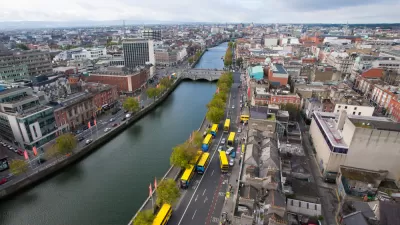Chuck Wolfe's photoshoot in the Palouse region of southeastern Washington State shows the timeless issues of human settlement, from agrarian to urban.
Writing in the Huffington Post, Wolfe depicts in words and photographs the rural character that to some is a world forgotten, where the relationship of land use and transportation displays differently, and clouds, roads, houses and colors show more art than science.

Yet, he notes, in lone shade trees, small towns and homestead remnants, there are urban lessons learned:
But envision an agricultural landscape, and look back at the farm-to-market basis for why and how many cities grew. Take a harder look, and see the reasons forests and farms have been elemental to growth management legislation, emulating the naturally evolved agricultural region that has always surrounded the City of Rome.
Consistent with his recent book, Urbanism Without Effort, Wolfe describes buildings and settlement forms that "motivate nostalgic reinvention" and continued fascination with Palouse imagery, even among the most die-hard of urbanists:
Small markets, the local bar, the library and the school -- no longer needed in one context, they rise again in reinvented urban settings with new tests of who gets and who pays.
FULL STORY: The Rural Landscape and Urban Lessons Learned

Study: Maui’s Plan to Convert Vacation Rentals to Long-Term Housing Could Cause Nearly $1 Billion Economic Loss
The plan would reduce visitor accommodation by 25,% resulting in 1,900 jobs lost.

North Texas Transit Leaders Tout Benefits of TOD for Growing Region
At a summit focused on transit-oriented development, policymakers discussed how North Texas’ expanded light rail system can serve as a tool for economic growth.

Why Should We Subsidize Public Transportation?
Many public transit agencies face financial stress due to rising costs, declining fare revenue, and declining subsidies. Transit advocates must provide a strong business case for increasing public transit funding.

How to Make US Trains Faster
Changes to boarding platforms and a switch to electric trains could improve U.S. passenger rail service without the added cost of high-speed rail.

Columbia’s Revitalized ‘Loop’ Is a Hub for Local Entrepreneurs
A focus on small businesses is helping a commercial corridor in Columbia, Missouri thrive.

Invasive Insect Threatens Minnesota’s Ash Forests
The Emerald Ash Borer is a rapidly spreading invasive pest threatening Minnesota’s ash trees, and homeowners are encouraged to plant diverse replacement species, avoid moving ash firewood, and monitor for signs of infestation.
Urban Design for Planners 1: Software Tools
This six-course series explores essential urban design concepts using open source software and equips planners with the tools they need to participate fully in the urban design process.
Planning for Universal Design
Learn the tools for implementing Universal Design in planning regulations.
City of Santa Clarita
Ascent Environmental
Institute for Housing and Urban Development Studies (IHS)
City of Grandview
Harvard GSD Executive Education
Toledo-Lucas County Plan Commissions
Salt Lake City
NYU Wagner Graduate School of Public Service



























